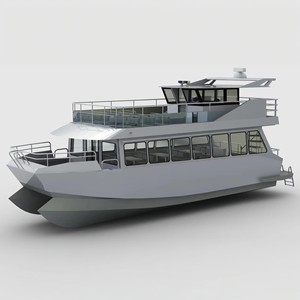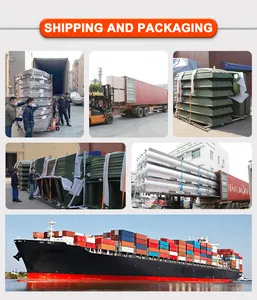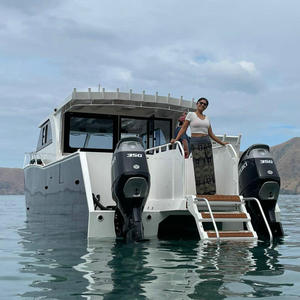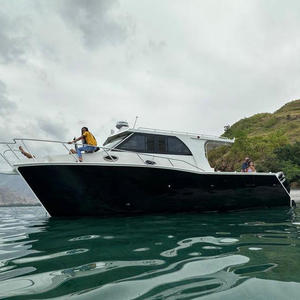(3161 products available)

































































































































































































































An outboard catamaran is a type of multihull boat with two parallel hulls of equal size and weight, powered by outboard motors. These catamarans are popular for recreational boating, fishing, and commercial purposes because of their stability, fuel efficiency, and versatility. There are several types of outboard catamarans, each designed for specific uses and preferences. Here are some of them:
Recreational Catamarans
These are the outboard catamarans designed for leisure activities such as cruising, sailing, and entertaining. They typically feature spacious decks, comfortable accommodations, and amenities like lounges, kitchens, and sleeping quarters. Recreational catamarans are popular among individuals and families seeking enjoyable and relaxing experiences on the water.
Fishing Catamarans
These are specialized for commercial and sport fishing activities. They are equipped with fishing gear, large fish holds, and workspace for processing the catch. Outboard fishing catamarans are designed to withstand rough seas and provide a stable platform for fishing activities. They also have features like rod holders, bait wells, and tuna towers.
Charter Catamarans
These are similar to recreational catamarans but are specifically built for chartering purposes. They are typically larger and have more accommodations to accommodate multiple guests. Charter catamarans often come fully equipped with a crew and amenities like kitchens, bedrooms, and entertainment systems, offering a comfortable experience for charter guests.
Expedition Catamarans
These are designed for long-distance travel and exploration in remote areas. They are built with durability and self-sufficiency, featuring large fuel and water tanks, solar panels, and ample storage space. Outboard expedition catamarans can operate in various conditions and are popular among adventure seekers and those undertaking extended voyages.
Commercial Catamarans
These are used for various commercial purposes, including transportation, tourism, tourism, and research. They are built for durability, fuel efficiency, and versatility, with customized configurations to suit specific commercial needs. Commercial catamarans can be equipped with cargo holds, passenger seating, laboratories, or accommodation for crew members.
Outboard catamarans are versatile watercraft that can be used for various purposes. Here are some of the usage scenarios.
Choosing the right outboard catamaran involves several key aspects.
Purpose
Determining the primary use of the catamaran is crucial. Whether it's for long-distance cruising, commercial use, chartering, or recreational activities like fishing or diving, the intended purpose will significantly influence the design, size, and features required. For instance, a catamaran for long-distance cruising might need more living space and storage, while one for fishing might require specialized gear and a spacious deck.
Size and Capacity
The size of the catamaran should be proportional to the number of people it will accommodate. For solo or couple sailors, a smaller catamaran around 30-40 feet might be ideal. Families or those planning to host guests regularly might require a larger model, ranging from 40 to 50 feet or more. Additionally, considering the storage space for gear, provisions, and equipment is essential.
Performance and Speed
In terms of performance, the type of sailing or motoring experience one desires is important. Outboard catamarans are generally faster than inboards due to less weight and better fuel efficiency. Those interested in speed and fuel efficiency should look for models with a sleek hull design and lightweight construction. The power of the outboard motors also plays a significant role in the catamaran's speed and performance.
Comfort and Amenities
For those planning to live aboard or use the catamaran for extended trips, comfort is paramount. Features like a spacious saloon, well-equipped kitchens, multiple cabins, and modern bathrooms can make a significant difference in liveaboard comfort. Adequate ventilation, natural light, and ergonomic design are also crucial for maintaining a comfortable living environment.
Build Quality and Materials
Outboard catamarans can be constructed from various materials, including fiberglass, aluminum, or composite materials. Each material has its advantages and disadvantages in terms of durability, maintenance, weight, and cost. A well-constructed catamaran with quality finishes will require less maintenance and have a longer lifespan. Inspecting the build quality, joinery, and overall finish is essential when choosing a catamaran.
Outboard catamarans are manufactured with some features that help to enhance their performance, safety, and comfort on the water. Here are some of their features and design elements:
Material
Outboard catamarans are made from high-quality materials such as fiberglass, aluminum, or composite materials. These materials are chosen for their durability, strength, and resistance to corrosion and environmental factors. Fiberglass offers a good balance of strength and weight, while aluminum provides added durability. Composite materials can offer high strength-to-weight ratios and increased performance.
Hull Design
The twin-hull design of catamarans provides several advantages. The hulls are typically flat with slight curvature, which helps to reduce drag and improve fuel efficiency. The hulls also have a sharp entry point and a wide beam, providing stability and minimizing rocking motion. This design allows for smooth sailing even in choppy waters. The catamaran's hulls are spaced apart, which provides a larger deck area and reduces the risk of slamming in rough seas.
Engines
Outboard motors are mounted on the transom of the catamaran. These outboards are easier to maintain and replace than inboard engines. Outboards also provide better fuel efficiency and reduce noise and vibration. The power of the outboard motors varies depending on the size and intended use of the catamaran. Larger catamarans for offshore use will have more powerful engines than smaller ones for inshore use.
Deck and Cockpit Design
The deck and cockpit of an outboard catamaran are designed for comfort and functionality. The deck is spacious and has non-slip surfaces for safety. It features ample storage compartments for gear and equipment. The cockpit is located at the rear and has comfortable seating, steering controls, and easy access to the engines. Some models also include a T-top or hardtop for shade and added protection.
Interior Amenities
Interior amenities on an outboard catamaran vary depending on the model and size. Smaller models may have basic features like a small cabin and storage space. Larger catamarans can have luxurious interiors with multiple cabins, a galley, a bathroom, and living spaces. The use of large windows and skylights provides ample natural light and excellent visibility.
Q1: What are the advantages of an outboard catamaran over a monohull?
A1: Compared to a monohull, the outboard catamaran has several advantages. First off, because of the hull's design, it has greater stability and less rocking motion. In addition, the twin hulls provide more deck space and make moving around easier. The catamaran is also more fuel-efficient since it displaces more water while having less hull to drag.
Q2: What maintenance does an outboard catamaran require?
A2: An outboard catamaran needs regular maintenance to stay in good shape. This involves routine cleaning and inspection of the hull to check for any indications of growth or deterioration. The outboard motors need regular maintenance, such as oil changes and propeller checks. The electronics and wiring systems should be examined regularly to ensure they are working correctly. Regular maintenance ensures the catamaran remains seaworthy and prolongs its lifespan.
Q3: How many people can an outboard catamaran hold?
A3: The number of people an outboard catamaran can accommodate depends on the specific model and design. A small leisure catamaran might comfortably accommodate four to eight people, while larger catamarans used for charter or commercial purposes can host 20 or more passengers. In addition to the passenger capacity, catamarans also have a crew capacity, usually limited to one or two people.
Q4: What is the maximum speed of an outboard catamaran?
A4: The performance of outboard catamarans varies depending on the design and engine size. Generally, they can achieve speeds ranging from 15 to 30 knots. Factors influencing speed include the weight of the catamaran, the power of the outboard engines, and the sea conditions. Lightweight catamarans with powerful outboard engines tend to reach higher speeds.